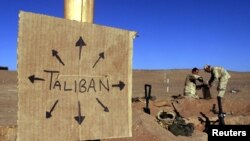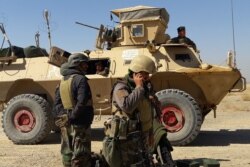The Taliban appear poised to take by force what they do not get through negotiations once U.S. and coalition troops complete their withdrawal from Afghanistan, according to a new assessment based on intelligence from United Nations member states.
The report, issued Thursday by the U.N. sanctions monitoring team for Afghanistan, warns that while the Taliban are still technically in compliance with the terms of last year's agreement with the United States, they have tightened their grip on power, exercising direct control over more than half of the country's district administrative centers while contesting or controlling up to 70% of territory outside of urban areas.
And U.N. member state intelligence agencies caution this may be just the beginning.
"Taliban rhetoric and reports of active Taliban preparations for the spring fighting season indicate the group is likely to increase military operations for 2021, whether or not a spring offensive is announced," the U.N. report said.
Intelligence indicates Taliban commanders have also massed their forces around key cities and towns, ready to strike, as part of a strategy to "shape future military operations when levels of departing foreign troops are no longer able to effectively respond."
The U.N. report further warns that there is little evidence to suggest the Taliban have done much to sever ties with the al-Qaida terror group, as required by the agreement with the U.S.
In contrast, the intelligence shows the relationship between the Taliban and al-Qaida "has grown deeper as a consequence of personal bonds of marriage and shared partnership in struggle, now cemented through second-generational ties."
"Members of (al-Qaida) have been relocated to more remote areas by the Taliban to avoid potential exposure and targeting," the report found. It said as many as 500 al-Qaida members — both with the core group and with the al-Qaida in the Indian Subcontinent (AQIS) affiliate — reside in at least 15 provinces.
Contact between the two groups has also continued, though the report said al-Qaida "has minimized overt communications with Taliban leadership in an effort to 'lay low' and not jeopardize the Taliban's diplomatic position vis-à-vis the Doha agreement."
The U.N. sanctions-monitoring team additionally warned AQIS "is reported to be such an 'organic' or essential part of the insurgency that it would be difficult, if not impossible, to separate it from its Taliban allies."
The Taliban on Thursday immediately rejected the U.N.'s findings.
"Unfortunately, this report has been compiled on the basis of false information from enemy intelligence agencies," according to a statement from Taliban spokesman Zabihullah Mujahid, translated from Pashto.
"Such one-sided reports call into question the impartiality of the U.N. Security Council and undermine its international credibility," Mujahid added, further accusing the U.S. of failing to abide by the terms of the Doha agreement.
"Representatives of the Islamic Emirate are also fully prepared for the inter-Afghan negotiating table, in order to make progress in the negotiations and implement all the clauses," he said.
U.S. officials Thursday acknowledged the report but emphasized that the only way to achieve a “just and durable” peace in Afghanistan is through ongoing inter-Afghan negotiations.
“Our ultimate goal is an Afghanistan that finds an end to four decades of conflict,” State Department spokesman Ned Price told reporters. "In that environment, terrorism is less likely to emerge."
Price also seemed to warn the Taliban against increased violence.
“The world will not accept in Afghanistan the establishment of any government imposed by force,” he said.
Other U.S. officials, including Ambassador Zalmay Khalilzad, special representative for Afghanistan reconciliation, have argued that a key motivation for the Taliban has been a desire for international acceptance, and that they understand they will sacrifice both acceptance and aid if they resort to violence.
The release of the U.N. report comes just days after U.S. military planners announced the U.S. withdrawal from Afghanistan is 30% to 44% complete, and that the pullout is ahead of schedule.
While the Doha Agreement called for all U.S. and coalition forces to be out of Afghanistan by this past May, U.S. President Joe Biden delayed the timeline, announcing in April that U.S. forces would compete the pullout by early September.
Still unanswered, however, are key questions about ongoing training for Afghan government security forces and how the U.S. will conduct counterterror operations, if needed.
The fate of peace talks between the Taliban and the Afghan government, scheduled to resume this week in Doha, is also uncertain.
Thursday's report from the U.N. sanctions monitoring team suggests the Taliban, at least, seem intent on giving the negotiations a chance if they can leverage their military advantage into concessions from the Afghan government. If not, the assessment of U.N. member state intelligence agencies points to more fighting.
The Taliban "is reported to be responsible for the great majority of targeted assassinations that have become a feature of the violence in Afghanistan, and that appear to be undertaken with the objective of weakening the capacity of the government and intimidating civil society," the report said.
Key Taliban leaders, including top deputies Mullah Mohammad Yaqub Omari and Sirajuddin Haqqani, "oppose peace talks and favor a military solution," the report found.
U.N. member state intelligence agencies also assess that despite some attrition, the Taliban's military force remains potent, boasting up to 100,000 fighters, including some units that have been placed in reserve, as well as units that specialize in explosives and rocket construction.
While still smaller than the Afghan government force, which stood at about 308,000 as of February this year, the U.N. reports the Taliban appear to be better positioned, and as a result, are denying Afghan government forces freedom of movement.
The Taliban appear to have increased their grip on northern parts of Afghanistan, the U.N. report said, in particular, where they "exert more control over road networks in the north than at any other time since 2001."
Money also does not seem to be an issue for the Taliban.
U.N. member state intelligence found the Taliban are generating anywhere from $300 million to as much as $1.6 billion in revenue annually.
Much of the money comes from drug trafficking, opium production, kidnapping and extortion, but intelligence suggests the Taliban are doing more to exploit Afghanistan's mining sector.
According to one U.N. member state intelligence service, mining alone earned the Taliban $464 million in 2020.
Ayaz Gul in Islamabad contributed to this report.













